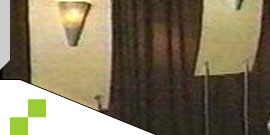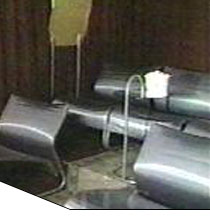



![]()

A show house that smiles? Eh bien!
By Mitchell Owens It is impossible to climb the stairs of the 1997 French Designer Showhouse and not imagine that you have stepped into a three-dimensional version of a brain-teaser cartoon for Sunday-bored children. Remember, this is a show house, so what is wrong with this picture? Con-Tact paper posing as bird's-eye maple. Place mats turned into lampshades. Terrazzo floor tiles on a kitchen counter top, and Corian, that ubiquitous counter material from DuPont, transformed into Mondrian-mosaic walls. And what about that bed in Jane Victor's and Jennifer Ellenberg's fifth-floor aerie, a steel platform eerily suspended by industrial-strength cables like something out of "2001: A Space Odyssey"? The French Designer Showhouse, running today through Nov. 16, is not the typical show house. Mind you, it is not the most influential showcase for interior design in the United States. That is firmly the preserve of the annual Kips Bay show house, renowned for grand rooms by august professionals. But if Kips Bay is the Metropolitan Opera, its French rival, which has appeared in New York every two years since 1989, is BAM (Brooklyn Academy of Music): provocative and contrary. The trompe l'oeil finishes alone tell the story. Unlike the laborious fool-the-eye surfaces that have been a show-house cliche, the "tortoise-shell" pilasters in Odile de Schietere's dining room are not trying to fool anyone. Though wonderfully executed, their essential humbleness is front and center: 1/4-inch wood boards casually tacked into place. This straightforward application gives Ms. de Schietere's room — where a wrinkly, rudely nailed canvas floor cloth cuts the Russian neoclassical chairs and marble-top consoles down to size — an appealingly temporary, degage air, like a party tent pitched for just one night. It is a neat trick, and more important, an apt symbol for a show house that is perhaps the most innovative in America, where fantasy and accessibility come together in one tidy inspirational package. First, an explanation. The title of the show house, held this year in an 1878 town house at 49 East 67th St. (between Madison and Park avenues), is somewhat misleading. Of the 20 designers and 17 artisans, only three – Jacques Grange, Odette Boulenger and Paul Mathieu — live and work in France. The rest are Americans, though some are French-born. The cultural designation of the show house derives largely from the name of its beneficiary: the American Hospital of Paris Foundation. But then there is the invention that the word "French" implies. These designers seem well aware that a majority of show-house visitors never hire decorators — magazines, not show houses, attract more new clients — and so they have tried nothing blatantly commercial. Which means no chintz, no antiques with stellar provenance, no robber-baron grandeur. Instead, the designers have had fun, offering settings, details and solutions that ought to remind decorators and clients alike that the designer worth hiring is the one with a nimble mind, not just a business card. In fact, two participating designers, Grange and Nancy Corzine, have stocked their rooms with furniture that visitors can actually go out and buy. The salon by the celebrated Grange has woven straw walls and billowing curtains of moss-green and cherry-red silk taffeta, with eclectic chairs, tables and sofas that he designed for John Widdicomb Co. of Grand Rapids, Mich. And Ms. Corzine's ground-floor space — cool, beige and vaguely 1940s — is a showcase for her new upholstered pieces and case goods (available to designers and decorators at her Third Avenue showroom). What these shopper-friendly settings mean to the rarefied genre of decorator show houses will cause serious debate in some circles, outrage in others. But the ramparts have been breached: Merchandising in show houses is here. Get used to it. Fortunately, the ideas outnumber the product plugs. Saddled with an outmoded, age-battered kitchen? "Paint, paint, paint," Jamie Drake said. "Short of demolition, it's the only solution." On the ceiling, walls and metal cabinets of the kitchen and breakfast area, Drake applied an icy pastel he called "angora-sweater blue" — Benjamin Moore's No. 792 — transforming the dreary space into something sleek and modern for a few hundred dollars. The breakfast area's awkwardly placed street-front windows were masked with a floor-to-ceiling curtain and, Drake proudly explained, the recessed fluorescent lights glow behind Coretex panels of milky corrugated plastic that cost $3 each at places like Home Depot. High style through the sensitive use of bargain goods is a motif. The gridlike wainscoting in Christopher Coleman's bathroom and dressing room is made of white strips of wood and squares of mirror from a hardware store. To block the dispiriting view of a construction site from the balcony off the sleek Lucite-and-oak bedroom designed by Jeanne-Aelia Desparmet-Hart, the artisans Philippe Soule and Donna Gutkin of Escabelle Design created a sculpture-cum-shield of autumn leaves glued to undulating frosted Lucite. "Before, it was like a tomb," Jean-Pierre Dovat said of his cellar-level room, which encloses an L-shaped pool. He vanquished the claustrophobic effects of the long, low, narrow room with cleverly angled mirrors — along the walls as well as underwater — and then used Con-Tact adhesive paper to give the changing room's sliding door and handrail the look of bird's-eye maple. "If you use them properly, in the right way, cheap things can be so beautiful," Dovat said. He also came up with the show house's best example of inspired recycling. Matchstick place mats from Gracious Home, bent into wide U shapes and lined with white paper, were turned into shades for the pool area's garish crystal light fixtures. Other staples of late 1960s and early '70s decor — silver Mylar, layer-cake banquettes, massive Lucite — are ubiquitous. The Gucci-and-Furstenberg wrap-dress revival has much to answer for here. The glossy brown hall by Myles Scott Harlan and Douglas Wilson, with its Lucite banister and stair treads encased in stainless steel, recalled such period night spots as Regine's. "Not all cheap things are bad," said Robert Couturier, a designer whose flamboyant impishness conceals a scholar's knowledge of 18th-century French decoration and architecture. Which explains why his room, a great salon tented with black-and-white cotton printed with iguanas and artichokes, contains wonders of every economic origin: a Louis XIV sofa in worn silk velvet flanked by flea-market tables topped with Bakelite; a folk-art bird sculpture made of buttons with African statues; a grand Roman Catholic reliquary alongside 1940s lawn chairs by Jean Royere. For the floor, Couturier created an area rug with copies of 18th-century maps of Paris covered with a Plexiglas sheet. A big mix, but, Couturier said, that's how people live today. "Haphazard is the most fulfilling kind of decor," he said, plopping down on the sofa and looking alarmed as it slid a few inches on the Plexiglas. "If you like something, then that is enough for it to be in your life," he continued, quickly regaining his composure. "That is the thread that holds your things together." |
